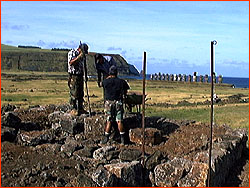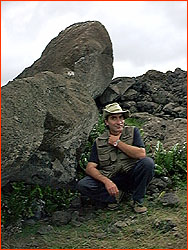 |
 |
 |
 Moai Platform Complete
Moai Platform Completeby Liesl Clark April 26, 1998 Our faces burn from the constant battering we receive from the wind. It dies briefly at dusk, just as the trucks are being loaded after a full day of filming outdoors. The ahu (platform) at Tongariki has been built for the moai-raising experiment, its back wall beautifully finished with large flat stones. A small, dirt-covered ramp made of rock leads up to the 1.5-meter platform. The exact dimensions of the ahu are 1.5 meters high by six meters long by four meters wide—large enough to accommodate the 15-ton concrete moai, which is still curing just outside the village of Hanga Roa.  In the overcast afternoon light, we drive along the south coast of the
island with Chilean archaeologist Claudio Cristino to inspect the many
stone ahu that remain there. Seemingly every rocky point on this rugged
coastline has remnants of a rectangular stone ahu structure on which moai
once stood. They now lie toppled, their faces hidden from view. "Ahu are
different all over the island because they were built by different tribes,"
explains Cristino. "First they would build the back wall of the platform
and the sloping ramp to the front would come last. The stone ramp was the
tool they used for raising the moai." Those same stones would then be used
to finish the platform structure.
In the overcast afternoon light, we drive along the south coast of the
island with Chilean archaeologist Claudio Cristino to inspect the many
stone ahu that remain there. Seemingly every rocky point on this rugged
coastline has remnants of a rectangular stone ahu structure on which moai
once stood. They now lie toppled, their faces hidden from view. "Ahu are
different all over the island because they were built by different tribes,"
explains Cristino. "First they would build the back wall of the platform
and the sloping ramp to the front would come last. The stone ramp was the
tool they used for raising the moai." Those same stones would then be used
to finish the platform structure.
Cristino believes the statues were toppled by humans as a consequence of warfare. "Between AD 600 and 900, about 100 people arrived onto the island which was, at that time, 165 square kilometers of good soil, water, springs, and dense vegetation. By 1600, there were more than 15,000 people. The pressure over resources was tremendous. The lower classes, who felt it most, revolted and the island went into social crisis. Ancestral worship ended and later slavery and even cannibalism set in." It is an apocalyptic view, but Cristino is convinced that Easter Island's inhabitants had reached the highest level of social anarchy, culminating in self-destruction. "Unlike other cannibalistic societies, here, cannibalism wasn't for ritual, it was for food." Lessons Learned (May 11) A New Way to Move a Moai (May 9) Moai is Upright (May 6) Moai Nearly Raised (May 5) A Tourist Attraction (May 3) The Secret of the Sledge (May 2) Moai Ready to be Raised (May 1) The Moai is Moved (April 30) 15-Ton Moai Removed from Mold (April 27) Moai Platform Complete (April 26) Moai Mold is Filled (April 24) Moai Mold Ready for Concrete (April 23) Statue Mold En Route (April 22) The Team Arrives (April 20) Arrival on Rapa Nui (April 17) Photos: Liesl Clark Move a Megalith | Dispatches | Explore the Island | Lost Civilization Resources | E-mail | Table of Contents | Easter Island Home Editor's Picks | Previous Sites | Join Us/E-mail | TV/Web Schedule About NOVA | Teachers | Site Map | Shop | Jobs | Search | To print PBS Online | NOVA Online | WGBH © | Updated November 2000 |